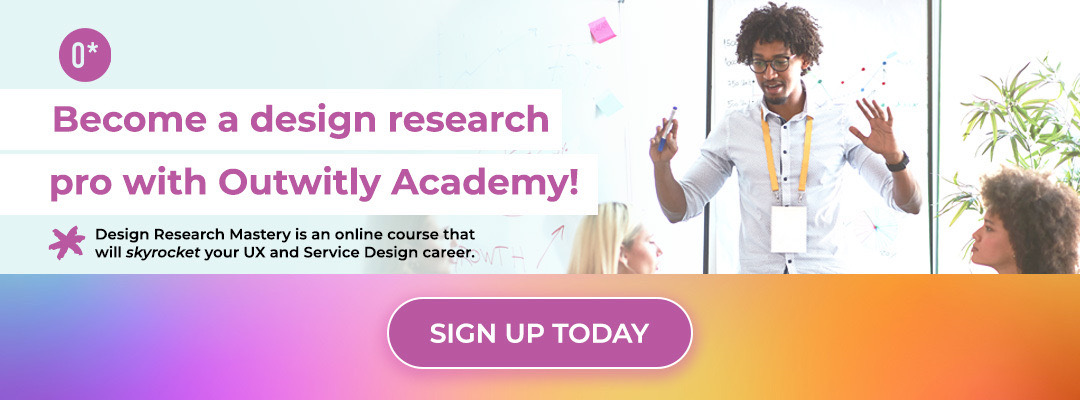
Author: Amy Sullivan
Creative problem-solving is one of the most rewarding aspects of doing UX and service design work. But when functional issues start to crop up within your team, problem-solving can be daunting, especially when you’ve got future sprints looming over your head.
That’s why sprint retrospectives (and post-mortems) are a necessity. Whether you’re a product/project manager, a designer, or any other practitioner, setting up opportunities for recapping after an achievement will help you improve group dynamics and operational efficiency.
In today’s blog (Part 1 of a two-part series), we’ll be focusing on sprint retrospectives, which are a very important part of continuous improvement on any ux, service design or product team. You may be wondering what the retrospectives are, you might be nervous to do them, or you might be so bored with retrospective meetings that you need some fresh approaches… In any case, we hope you’ll find some pointers below to take with you on your ux or service design journey!
We’ll be walking you through:
-
- Sprint Retrospectives vs Post-Mortems: What’s the Difference?
- Prepping Project Teams for Sprint Retrospectives
- Our 5 Favourite Sprint Retrospective Methods
1. Sprint Retrospectives vs Post-Mortems: What’s the Difference?
It’s normal for teams to go through some growing pains together. In fact, growing pains are so common in organizational behaviour that a psychologist named Bruce Tuckman even coined a term for it, called “storming,” in his FSNP concept and group development model. And, after much reflection, he ended up adding a fifth stage to his model, called “adjourning,” to address team dynamics after a group effort is finished.
Both sprint retrospectives and post-mortems were created to “adjourn” or take a pause to reflect on how a team performed together and identify opportunities to improve moving forward. But they’re both very different kinds of meetings. That may come as a surprise if you’ve heard these terms used interchangeably — it’s not unusual to hear somebody mix the terms together and say, “Let’s arrange a post-mort-retro on this.”
We find that distinguishing these two terms and their specific differences can help us identify intended outcomes and make the whole process less murky for everybody involved. These meetings can be stressful enough as it is! The last thing you need is for participants to get confused. Especially if you’re working in design and tech environments, knowing the difference will help you navigate and facilitate these meetings with confidence.
So let’s get to it! Here are the key differences:
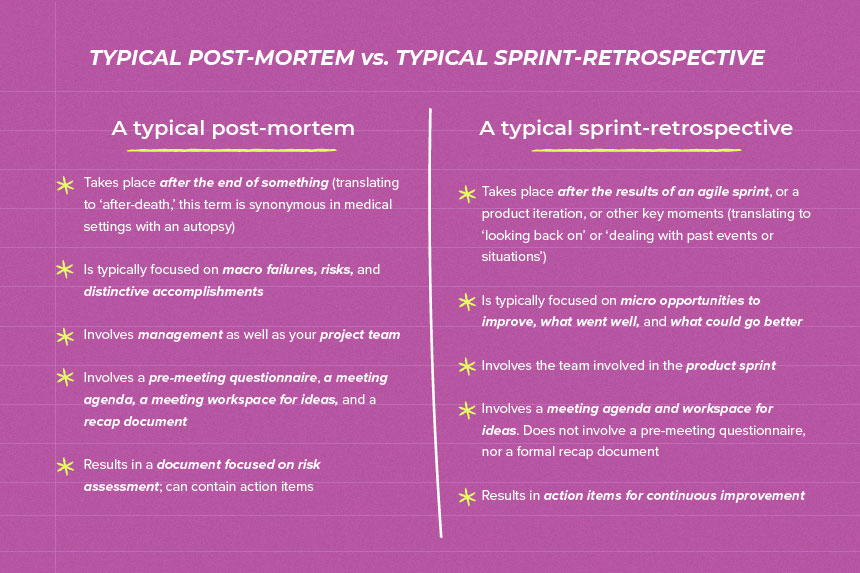
Many dev-ops or site-reliability engineering teams may already be familiar with post-mortem and retrospectives, but if you’re working in HCD and service design, you may not be interacting with engineers at this level. And other product or design teams may have had post-mortems before, but they may not understand the differences highlighted above.
Note: The risk assessments that come out of a typical post-mortem are still a necessary part of long-term project success! Outwitly Academy’s Design Research Mastery course dedicates five lessons to project success, including an in-depth lesson on risk mitigation. Check it out here:
Hopefully this section has given you more context for choosing how and when to use each type of meeting, and which one might be the most relevant to your team, so you can guide them in the right direction!
For the rest of this blog, we’ve chosen to put sprint retrospectives in the spotlight, because we want to emphasize how important they are (even if they’re the lesser-known term!). We love them for the results-oriented perspective they promote, which is especially crucial to forging effective UX and service design teams, maintaining a culture of collaborative service and leading exceptional software design.
Since these meetings are helpful for teams in so many different disciplines, we’ve laid out our best generalist recommendations and insights below with all practitioners in mind.
2. Prepping Project Teams for Sprint Retrospectives
Pointing out problems can feel awkward at first — but do you know what’s even more awkward? Being caught by surprise. Looping teammates into your plans is part of project management 101, and it’s a good rule of thumb for any practitioner. If you’ll be holding sprint retrospectives, let your team know — before their work starts!
If you do, your team will be:
- More at ease when dealing with problems, knowing that there will be time and space for them to air grievances and discuss solutions.
- More reflective during their workdays, and they’ll come to a retrospective more prepared.
- Less fearful that a retrospective has been called because of something they did wrong.
- More trusting in the process and in the team’s leadership.
You’ll also want to start with an icebreaker — we love “divisive” topics that are light, silly and relatable but tend to incite strong opinions. They warm people up and get them used to talking about their feelings in a low stakes setting. Here are some of our favourite icebreakers for retrospectives:
- “Who is your least favourite popstar?”
- “What’s your idea of a nightmarish vacation?”
- “What snack food do you hate?”
View this post on Instagram
And to keep your teams interested and engaged as time goes on, it’s a great idea to mix it up and not use the same facilitation methods all of the time. Below, we’ve listed our favourite methods for retrospectives that are sure to help you glean new insights and build your team’s communication skills.
PS: We’ve linked to some templates in Miro that we love, but you can adapt and facilitate these methods in any tool or setting.
3. Our 5 Favourite Sprint Retrospective Methods
When you’re getting ready to facilitate a sprint retrospective, set aside some substantial time to think about which method would bring out the best in your team. Are they mostly shy or mostly talkative? Or maybe half-and-half? Would they enjoy a silly metaphor or would they appreciate a more straight-forward approach? Read on to learn more about each of your options!
Method 1: Start, Stop, Continue
This is a classic! We love a minimal, colour-coordinated layout. For this method, you ask your team to list what they observed from the last sprint and what should change or stay the same.
Have them list what initiatives they think the team should start doing, what issues should stop occurring, what they want to see continue, and group them by these categories. Use a green theme for the “start” section, red, for “stop” and yellow for “continue.”
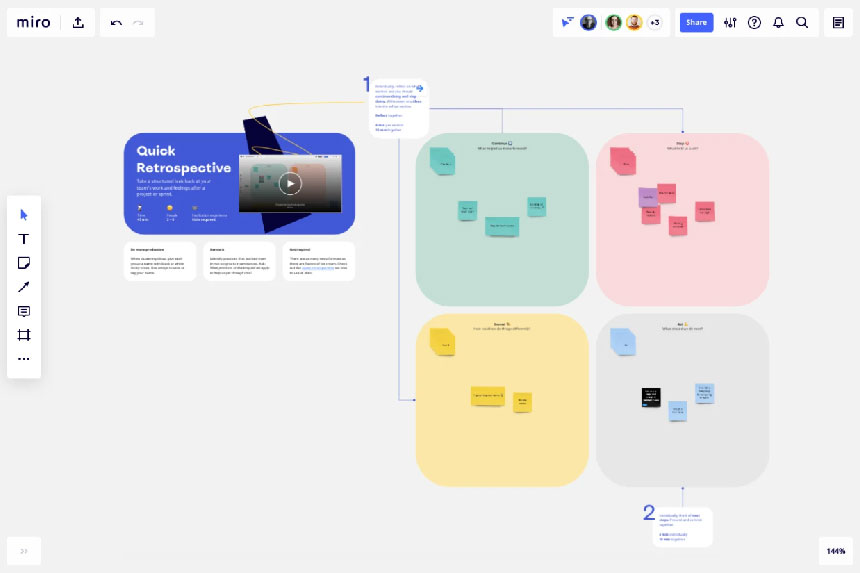
Use the Quick Retrospective template (shown above) in Miro.
Method 2: Rose, Bud, Thorn
This sprint retrospective method is poetic! It also implies that triumphs, errors and other challenges are all part of the same healthy, organic process. You and your team will group your contributions according to the parts of a rose.
- “Rose” points are positive outcomes and what’s working well.
- “Bud” points are potential and future opportunities.
- “Thorn” points are challenges and difficulties.
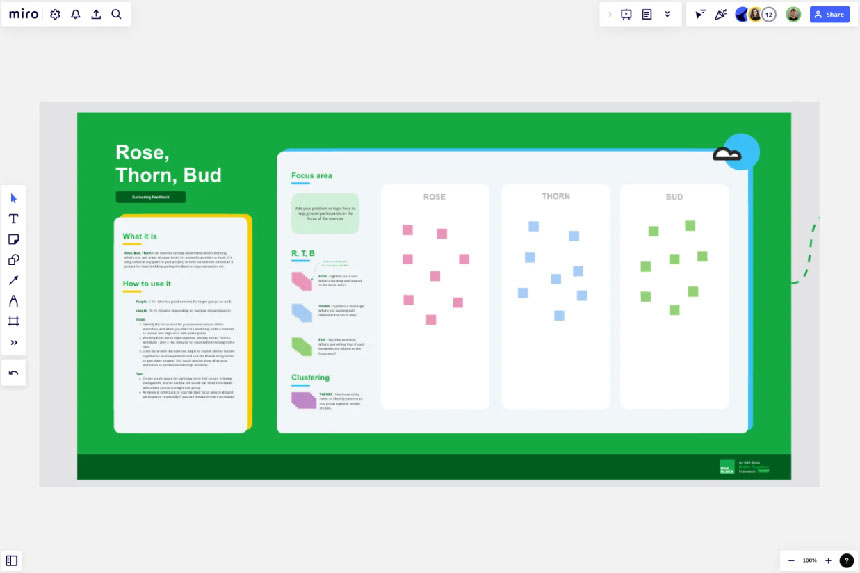 Use the Rose, Bud, Thorn retrospective template (shown above) in Miro.
Use the Rose, Bud, Thorn retrospective template (shown above) in Miro.
Method 3: Mad, Sad and Glad
Emotions can be difficult and awkward to talk about, especially in work settings. This method directly invites team members to broach those difficult subjects instead of waiting for them to work up the nerve.
If you’ve done some (or a lot of) empathy mapping in your human-centered design (HCD) work, you know that understanding the “why” behind users’ reactions and feelings is important for problem-solving. The same goes with your team! Show empathy and make sure you understand why something in the process didn’t work for them, so that you can work together on an informed solution.
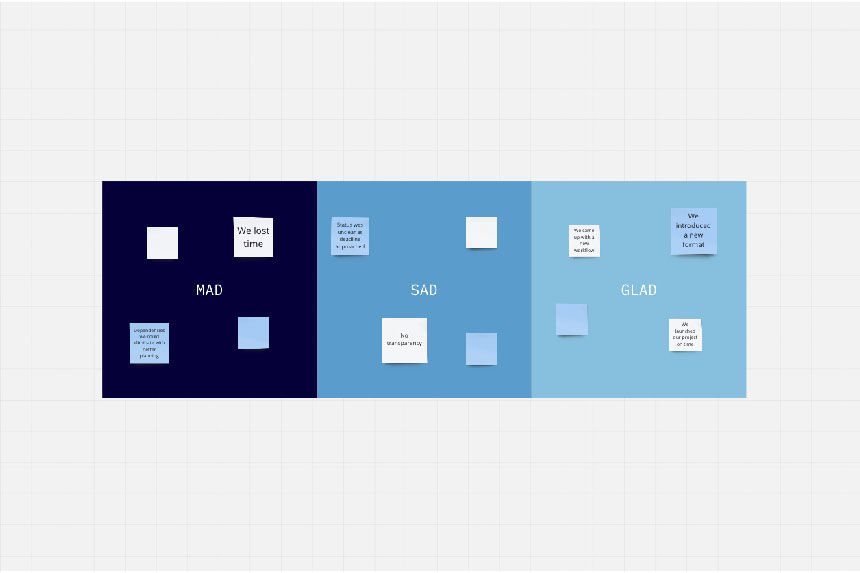
Use the Mad, Sad, Glad retrospective template (shown above) in Miro.
Note: The way that you choose to facilitate a sprint retrospective might be influenced by your team or organization’s capacity for embracing change and staying solution-oriented. These are qualities that also determine an organization’s UX maturity level. Learn more about the UX maturity scale and how your team measures up with our free downloadable!
Method 4: Starfish
We like this retrospective method because it digs a bit deeper than the others. It asks attendees to brainstorm observations based on five categories:
-
- What should we keep doing?
- What should we do less of?
- What should we do more of?
- What should we stop doing?
- What should we start doing?
Some people might be hesitant to speak up at first, and probing further with more specific questions or reframing questions can help prompt them.

Use the Starfish retrospective template (shown above) in Miro.
Method 5: Sailboat
Who doesn’t love a sea metaphor? (Thar, she blows! A metaphor indeed approaches!) This method invites you to compare your last sprint to a sailboat out on open waters. Your questions will look like this:
- Like the wind, what propelled your team/project forward? What were the key strengths?
- Like the anchor, what held you back? What slowed you down?
- Like the sun, what made you feel good?
- Like rocks or a reef, what future risks have you noticed ahead?
You can extend the metaphor however you’d like and add more questions. What would represent the water, the sails, sealife, oars, etc.? This approach is sure to crack a smile or two and loosen everyone’s inhibitions with a little bit of humour.
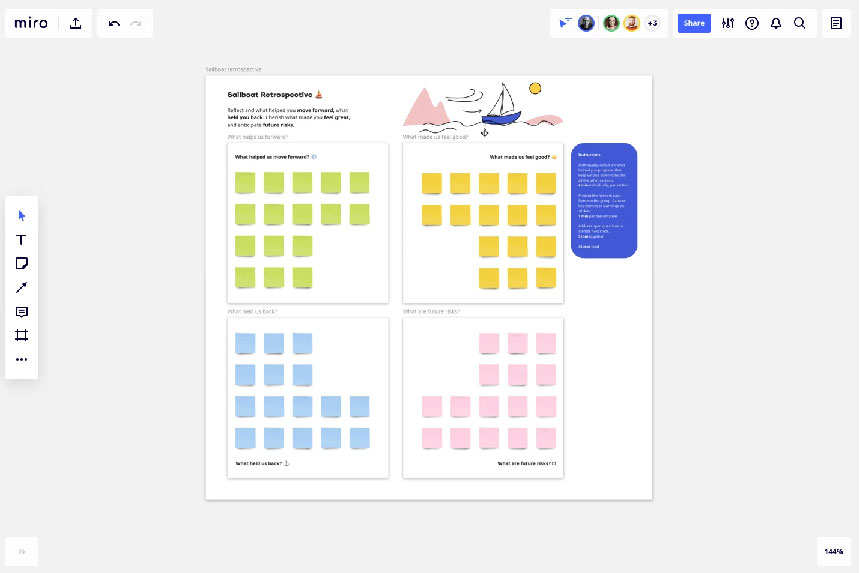
Use the Sailboat retrospective template (shown above) in Miro.
Don’t forget the main attraction: your action items!
No matter which method you choose, it’s important to also lead a discussion of the common themes you notice in everyone’s contributions, and co-create a list of action items to bring into your next sprint before you part ways. (And make sure to follow up with an e-mailed list of them after the call!)
We hope that you enjoyed reading about sprint retrospectives and our favourite methods for running them. The variation in these methods is a great example of how simply reframing a question can spark new thoughts and glean further insights. (See our blog on in-depth interviews for more thoughts on formulating great questions.)
If a full-on sprint retrospective is new to your team, or it feels like too big of a step to start with, we suggest introducing your team to reflective thinking in small ways first. Is there a simple solo practice you could introduce to get the ball rolling? What about some preliminary conversations or informal interviews?
After all, truly great facilitation is about being receptive to the group participating in your retrospective and their needs. In order to exude confidence, lead balanced discussions and set your teammates up for success, you need to develop your Agile facilitation mindset.
Luckily, that’s the subject we’re moving on to in our next blog. Keep an eye out for Sprint Retrospectives Part 2: Agile Facilitation!
